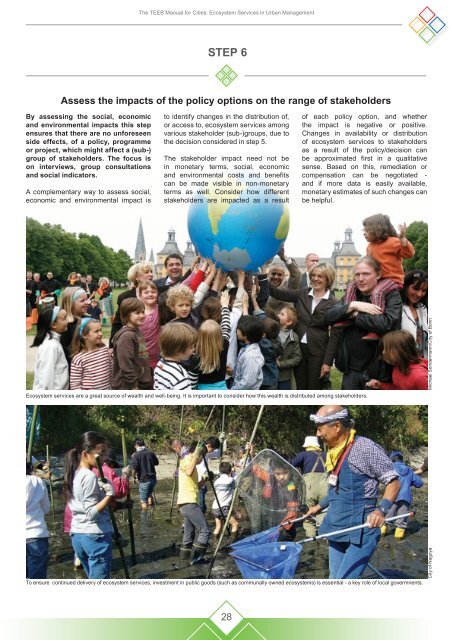TEEB Manual for Cities
TEEB Manual for Cities
TEEB Manual for Cities
You also want an ePaper? Increase the reach of your titles
YUMPU automatically turns print PDFs into web optimized ePapers that Google loves.
The <strong>TEEB</strong> <strong>Manual</strong> <strong>for</strong> <strong>Cities</strong>: Ecosystem Services in Urban ManagementStep 6Assess the impacts of the policy options on the range of stakeholdersBy assessing the social, economicand environmental impacts this stepensures that there are no un<strong>for</strong>eseenside effects, of a policy, programmeor project, which might affect a (sub-)group of stakeholders. The focus ison interviews, group consultationsand social indicators.A complementary way to assess social,economic and environmental impact isto identify changes in the distribution of,or access to, ecosystem services amongvarious stakeholder (sub-)groups, due tothe decision considered in step 5.The stakeholder impact need not bein monetary terms, social, economicand environmental costs and benefitscan be made visible in non-monetaryterms as well. Consider how differentstakeholders are impacted as a resultof each policy option, and whetherthe impact is negative or positive.Changes in availability or distributionof ecosystem services to stakeholdersas a result of the policy/decision canbe approximated first in a qualitativesense. Based on this, remediation orcompensation can be negotiated -and if more data is easily available,monetary estimates of such changes canbe helpful.Ecosystem services are a great source of wealth and well-being. It is important to consider how this wealth is distributed among stakeholders.To ensure continued delivery of ecosystem services, investment in public goods (such as communally owned ecosystems) is essential - a key role of local govermnents.City of Nagoya Michael Sondermann/City of Bonn28
















